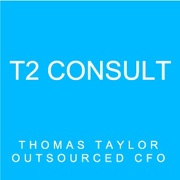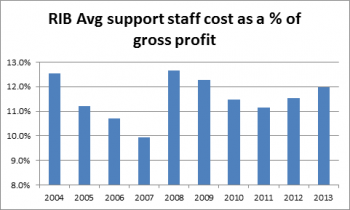The Cost of Standing Still In the Back Office
If it ain’t broke don’t fix it… however
Modern cloud back-office systems are so much more efficient than the older ones. So much so that not replacing old systems has become a strategic disadvantage for a lot of firms. If it ain’t broke don’t fix it is often the best thing to do but having accounts people rekeying data and doing manual invoicing on old-fashioned software is just a waste of money. It’s also fertile ground for errors and maybe even fraud. Let’s be clear; it’s not just about a shiny new system, it’s about managing total back office costs. RIB Report collects benchmarking data for support staff costs. Whilst not purely back-of-house costs it does show that support costs trend independently to gross profit. You can see in the following graph that costs reduced as a proportion of gross profit up until 2007 and then increased as profits fell in 2008.
Basically costs have been fairly static for a while but I believe that’s changing and they now can be a lot lower. What matters most is, rain or shine, if your costs are higher than your competitors you lose. It would be easy to just talk at a high level about a few examples but instead I want to list some of the areas that have improved the most. It’s important to remember that the following systems are not highly complex or difficult to implement, not like systems were five, or even three, years ago. Most are basically available off the shelf and just need to be customised for you business.
Temp payroll. Online timesheets and automated client approval workflows have completely revolutionised how temp payroll is processed. There is some setting up to do but after the client electronically approves a timesheet payroll is basically automated. A quick check for reasonableness is all that’s required. No more entering and checking timesheets. Good systems produce client invoices at the same time, and margin reports, and they also account for and help you manage on-costs like payroll tax.
Related: Why You Will Find It Hard To Get The Big Payday
Candidate on-boarding. Collecting candidate pay details, super and tax forms can all be automated. Candidates simply fill them in online.
Automated super payments. If you have ever tried to navigate superfund webpages trying to make payments you’ll know how much time automating this process can save. Good systems like Xero do it easily.
Easy year-end payment summaries. It should be just a few clicks, not days of work like it used to be.
Automatic debtor reminders. Systems like Debtor Daddy that link up to your accounts system and send out automatic reminders with the messages growing is gravity as the debt ages. They can even send reminders that an account will be due soon. These systems have proved to be remarkably effective and save enormous amounts of time yet cost less per month than an employee does per hour.
Automatic perm invoices. No more typing out an order and then having it rekeying by accounts. Most cloud applicant tracking systems can raise a draft invoice in Xero as soon as the placement is closed.
Bank feeds. This might sound like a small thing but anyone who has used them would never go back. You get a daily understanding of cash position and who has paid. With faster invoice matching you always have an up-to-date debtors listing. Payments are also posted daily so there is no trying to remember what something was at the end of the month. Any problems are sorted out right away.
Cash flow forecasting. There are a number of great cash flow forecasting systems than take the data from your accounts system and help you better manage cash.
Staff payroll. Staff get their own portal to see their details, get copies of payslips, apply for leave and claim expenses. Processing time is substantially reduced.
See a P&L anywhere, anytime. I’ve heard a few people now say that, for the first time, they have a proper understanding of what’s going on in their business because it’s so easy to log in and see what’s going on in real time.
Fastest month-end processing. If your accounts staff are doing a proper month-end, and they should be, month-end journals in Xero take about 10% of the time they used to take in older systems.
Alignment with your end of year tax accounts. It’s a rare SME where the accounting system matches the annual accounts. With cloud systems your tax accountant logs in and works with the live data. It might sound like its not important but it will save you many hours and headaches; especially when you sell.
Just better design. Hundreds of small ways of making data-entry easy combined with simplified design makes for faster training and less errors. The combined effect of these types of efficiencies simply equates to less human handing: less hours needed do something and less errors. Both these things mean tangible cost savings. It’s no longer just the big end of town that can drive down processing costs. It’s clear now that as more and more small and medium sized firms use this technology anyone that’s left behind will be at a disadvantage.
The Shock of the New
Most of us have been through complex front-office system implementations and are justifiably wary of change but there are a few reasons why back of house not as daunting.
- Good accounting systems are in many ways intentionally rigid to ensure better control, and modern systems have a lot fewer choices than older ones did. This is actually a great thing and makes staff training so much easier.
- Instead of trying to be all things to all people Xero accounting system, for example, is intentionally fairly vanilla and supplemented by an ecosystem of, often industry specific, specialised “add-ons”.
- Accounting systems are based on the well proven disinclines of double-entry accounting. They are designed to process many transactions in a disciplined way. Essentially all they do is add up. Workflows are less varied and, lets face it, pretty dull - all the more reason to make them simple and robust.
There are some pitfalls of course but, on the whole, the process of changing over back office is much less painful than it used to be.
Get an easy win, if you pick the right horse.
 We know that technology based disruption is coming to the industry in the same way it’s affected many other industries. You can probably tell that I think that the Xero accounting system is fantastic, it really is, but some of these other systems are pretty hot as well; like the great new electronic timesheet payroll systems. For back-office, we need to focus on reducing costs and having robust systems. The challenge is to decide what elements of change to embrace and how to do that efficiently.
We know that technology based disruption is coming to the industry in the same way it’s affected many other industries. You can probably tell that I think that the Xero accounting system is fantastic, it really is, but some of these other systems are pretty hot as well; like the great new electronic timesheet payroll systems. For back-office, we need to focus on reducing costs and having robust systems. The challenge is to decide what elements of change to embrace and how to do that efficiently.
To discuss this further please call Thomas Taylor of T2 Consult on +61 438 985 662


 By
By




